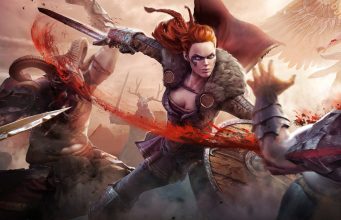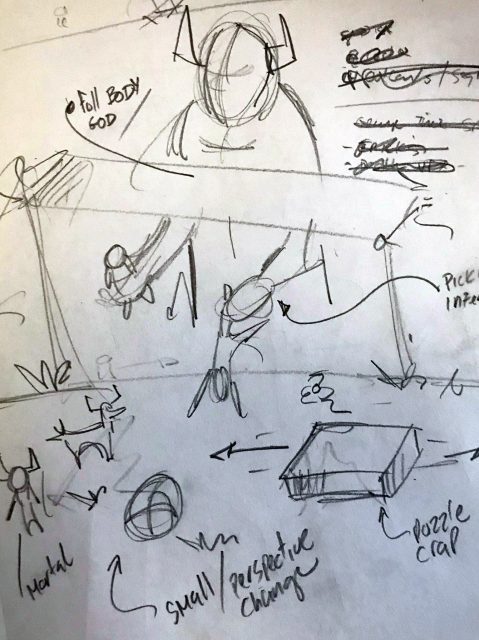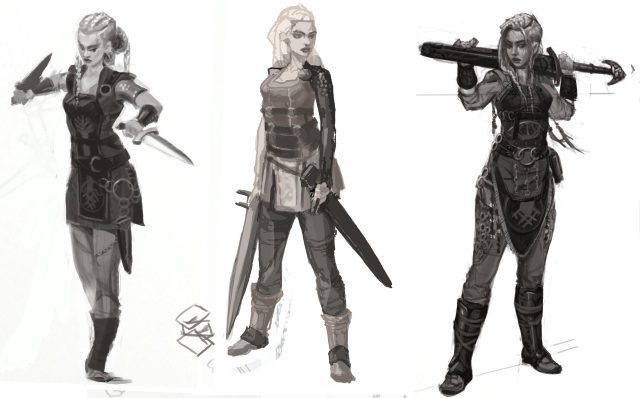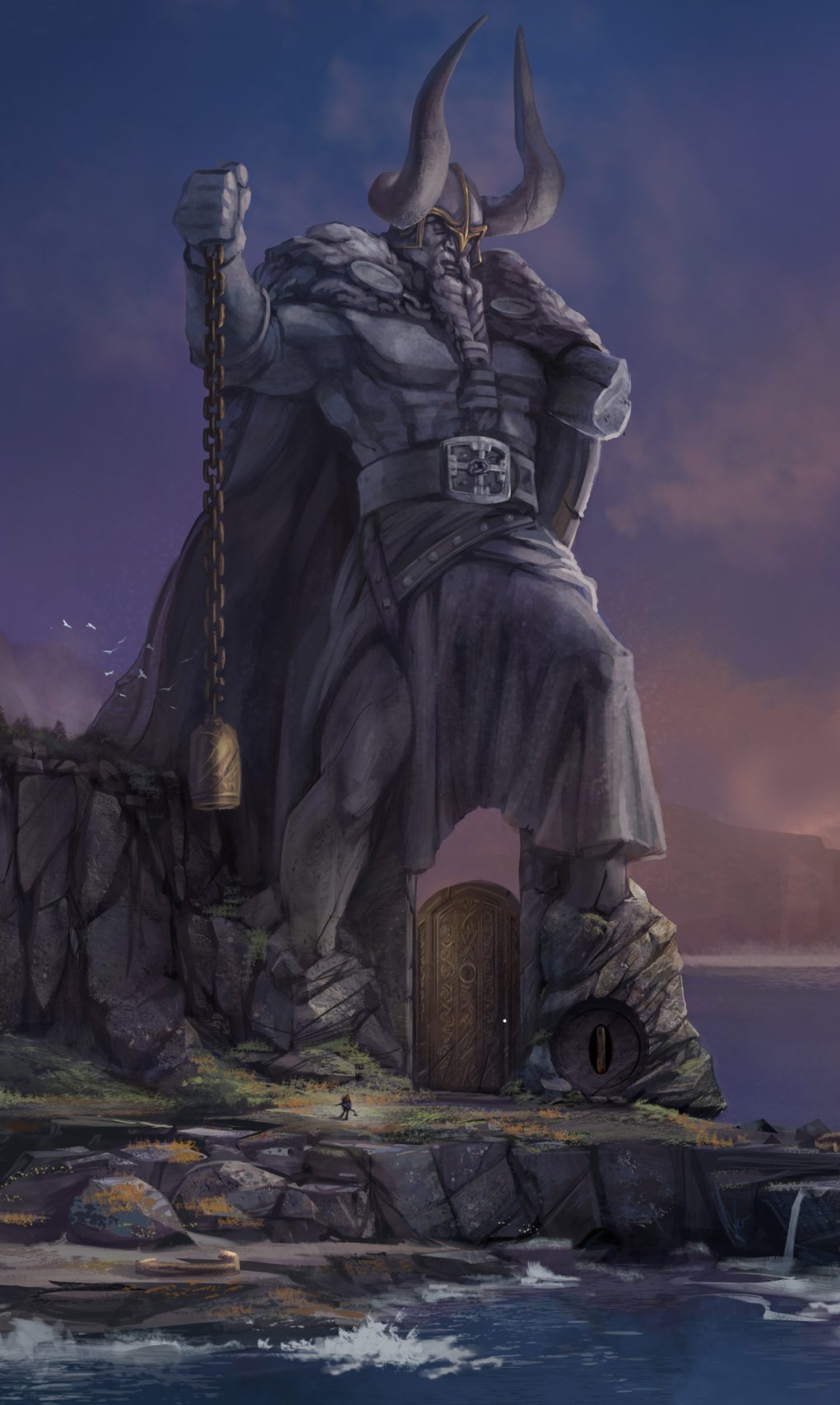
Sanzaru Games has been working closely with Oculus Studios since the early days of the Oculus Rift. And while the studio has three other VR games to its name, none of them come close to the scale of Asgard’s Wrath—in fact, Oculus believes that the game is the largest VR production to date. In speaking to Sanzaru’s Grace Morales Lingad and Oculus Studios’ Mike Doran, we learned of the surprising twists and turns the project took on its way to becoming the VR epic that it is today, and get a glimpse at the artwork that inspired and guided the game’s impressive visuals.
Editor’s Note: The big, beautiful pictures and exclusive artwork in this article are best viewed on a desktop browser with a large screen or in landscape orientation on your phone. All images courtesy Sanzaru Games and Oculus Studios.
A Toybox and a Sketch
 Though it launched just this week, Asgard’s Wrath can trace its roots back to even before the Oculus Touch controllers had launched. Oculus revealed Touch way back in 2015 alongside a demo built to show off the controllers called Toybox. In the demo players, used the controllers to play with doll-sized toys. Especially at that time, when 6DOF hand controllers were quite novel, there was a certain novelty to playing with these little toys and watching them move around on a table in front of you as if you were a god towering over the likes of little minions. It was this contrast of scales which was the first inspiration for what would—more than four years later—become Asgard’s Wrath, said Mike Doran, Executive Producer at Oculus Studios.
Though it launched just this week, Asgard’s Wrath can trace its roots back to even before the Oculus Touch controllers had launched. Oculus revealed Touch way back in 2015 alongside a demo built to show off the controllers called Toybox. In the demo players, used the controllers to play with doll-sized toys. Especially at that time, when 6DOF hand controllers were quite novel, there was a certain novelty to playing with these little toys and watching them move around on a table in front of you as if you were a god towering over the likes of little minions. It was this contrast of scales which was the first inspiration for what would—more than four years later—become Asgard’s Wrath, said Mike Doran, Executive Producer at Oculus Studios.
“As Sanzaru was wrapping development on VR Sports [a 2016 Oculus Touch launch title], we approached them with the idea of doing a game set in the perspective of Toybox: manipulating smaller objects in a larger ‘god’ form.” Following those conversations, Sanzaru Games Creative Director Mat Kraemer drew a quick sketch which, according to an Oculus spokesperson, “effectively gave birth to the game.”
I can’t help but laugh at the scrawled text in the sketch as I know now what Kraemer and his team at the time didn’t—that “puzzle crap,” and the other hastily written notes, were fated to turn into 30+ hours of gameplay in one of VR’s biggest productions to date, a task which wouldn’t come to fruition for another four years.
Becoming the Hero
 The form that Asgard’s Wrath would eventually take was not clear right off the bat, Doran explained.
The form that Asgard’s Wrath would eventually take was not clear right off the bat, Doran explained.
“Before we landed on Action/Adventure RPG, Asgard’s Wrath went through many identities. It was even a tower defense game at one point. There are elements of that old design in a few of the more cinematic battles as well as our entire UI for inventory. That shelf based system came directly from an early interface that was created to manage setting up defenses.”
Doran recalled that Sanzaru built a prototype based on the ‘god-scale’ concept which ultimately paved the way for another huge part of the game’s concept.
“Early on, you were only in this god form; you’d manipulate objects in the world and defeat monsters to help an AI human-scale character complete goals and advance through the environment. One of the [prototypes] had the AI you were protecting run into a series of caves, emerging with a sword and shield,” Doran said, “Every person that played this had similar feedback: ‘this is cool, but I want to see what’s inside the cave.’ Sanzaru put together a prototype [where you could switch] between human and god scale, and it was instant magic.”
Once it was clear that the player would play as both a god-like overseer and as the mortal hero themselves, Sanzaru realized they’d need to build a melee combat system with the depth to sustain hours of play. Doran said the team “spent a good nine or so months just expanding and building out the combat.”
 Sanzaru’s Grace Morales Lingad, Lead Designer on Asgard’s Wrath, recalled some of the challenges faced therein.
Sanzaru’s Grace Morales Lingad, Lead Designer on Asgard’s Wrath, recalled some of the challenges faced therein.
“One-to-one melee combat is arguably the ‘holy grail’ of gesture-based gaming, and for Asgard’s Wrath […] we foolishly decided to take a stab at it! That ambition was rife with challenges: figuring out the spacing between enemies and the player; addressing exploits inherent to a combat system based on players moving their bodies instead of pressing controller buttons; testing and tuning to accommodate different player behaviors; the list is endless,” said Lingad. “We experimented with incorporating more physics-based gameplay in the melee combat, but ultimately we opted to go in another direction because we wanted to prioritize clarity rather than pure simulation. For instance, we wanted to minimize disruption of the player’s one-to-one (hand-to-weapon) interactions, so we don’t slow the player’s hand and weapon down when cutting through enemies.”
Continued on Page 2: The Ways of Old »
The post ‘Asgard’s Wrath’ Behind-the-scenes – Insights & Artwork from Sanzaru Games and Oculus Studios appeared first on Road to VR.
from Road to VR https://ift.tt/2p725At
via IFTTT

No comments:
Post a Comment